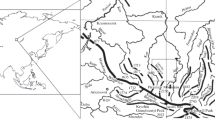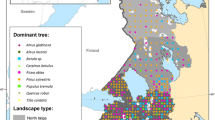Abstract
The insular pine forests of the Trans-Volga–Kazakh province of the Black Sea–Kazakh steppe region have high biodiversity and are relict in nature. The problems of their study and conservation are relevant in the context of increasing anthropogenic impact and climatic changes. A comprehensive analysis was performed for the floristic composition of communities of pine forests from the Burabai, Karkaraly, and Buzuluk national parks, the Naurzum Reserve, the Kanonersky forestry enterprise (south of the Priishimsky altitudinal zone pine forests), the pine forests of the Ilmensky Reserve and the Burlinsky altitudinal zone located in forest–steppe regions near the northern border of the province based on our own field materials and published data. For the first time, the data on the floristic diversity of all large pine forests in the province (the geographical aspect) are summarized in a unified manner. The similarity in the taxonomic, geographical, ecological, morphological, and coenotic structure of the floristic composition of all isolated insular pine forests indicate the presence of historical links and their relic character. The results of the correlation and cluster analysis of floristic lists showed a different degree of similarity between pine forests in different parts of the province in connection with the specific physical and geographical conditions. Three groups of pine forests have been identified: (a) pine forests of the sandy massifs of the Naurzum Reserve and the Kanonersky forestry enterprise, which have the most xerophilic appearance and are poor in composition, with a predominance of steppe species and turf grasses; (b) pine forests of granite massifs of the Kazakh Uplands (Burabay and Karkaraly national parks) with an average species richness; (c) the Buzuluk and Burlinsky pine forests, which occupy the most northern, borderline position in the province, with high floristic diversity and increased participation of forest species.



Similar content being viewed by others
REFERENCES
Belt pinewoods of the Irtysh River basin, in Trudy Laboratorii lesovedeniya (Transactions of the Forest Science Laboratory), Gael’, A.G., Ed., Moscow: Akad. Nauk SSSR, 1962, vol. 4.
Elumeeva, T.G. and Onipchenko, V.G., Assessment of the generic coefficient in treeless phytocenoses of the Teberda Nature Reserve, Materialy III Vserossiiskoi shkoly-konferentsii “Aktual’nye problemy geobotaniki” (Proc. III Al-Russ. School-Conf. “Urgent Problems in Geobotany”), Petrozavodsk, 2007, pp. 322–326.
Flora SSSR (Flora of the USSR), Komarov, V.L., Ed., Moscow: Akad. Nauk SSSR, 1934–1964, vols. 2–3, 5–6, 8–14, 16–17, 19–20, 22, 25–26, 30.
Flora of vascular plants of Central Russia: database, 2001. https://www.impb.ru/eco. Accessed May 15, 2019.
Gorchakovskii, P.L., Lesnye oazisy Kazakhskogo melkosopochnika (Forest Oases of the Kazakh Upland), Moscow: Nauka, 1987.
Gorchakovskii, P.L., Zolotareva, N.V., Koroteeva, E.V., and Podgaevskaya, E.N., Fitoraznoobrazie Il’menskogo zapovednika v sisteme okhrany i monitoringa (Phytodiversity of the Il’men Nature Reserve in the System of Protection and Monitoring), Yekaterinburg: Goshchitskii, 2005.
Interactive Agricultural Ecological Atlas of Russia and Neighboring Countries. Economic Plants and their Diseases, Pests and Weeds, Afonin, A.N., Greene, S.L., Dzyubenko, N.I., and Frolov, A.N., Eds., 2008. http://www.agroatlas.ru/ru/index.html. Accessed March 23, 2019.
Illyustrirovannyi opredelitel’ rastenii Kazakhstana (Illustrated Guide for Identification of the Plants of Kazakhstan), Goloskokov, V.P., Ed., Alma-Ata: Nauka, 1969, vol. 1.
Karamysheva, Z.V. and Rachkovskaya, E.I., Botanicheskaya geografiya stepnoi chasti Tsentral’nogo Kazakhstana (Botanical Geography of the Steppe Zone of Central Kazakhstan), Leningrad: Nauka, 1973.
Khrustaleva, I.A., Conspectus of flora of the Burlinskii belt pinewood (Altai krai), Rastit. Mir Aziat. Ross., 2009, no. 2 (4), pp. 54–65.
Kin, N.O., Flora of the Buzuluksky Bor National Park (vascular plants), in Trudy nauchnogo statsionara-filiala Instituta Stepi UrO RAN Buzulukskii bor (Transactions of Scientific Buzuluksky Bor National Park Stationer, Ural Branch of the Institute of Steppe, Russian Academy of Sciences), Yekaterinburg: Ural. Otd., Ross. Akad. Nauk, 2009, vol. 2.
Lavrenko, E.M., Provincial division of the Black Sea-Kazakh subregion of the steppe zone of Eurasia, Bot. Zh., 1970, vol. 55, no. 12, pp. 609–625.
Online catalogue of vascular plants of the Asian part of Russia, Siberian Branch, Russian Academy of Sciences, 2001. http://www-sbras.nsc.ru/win/elbib/atlas/flora. Accessed March 23, 2019.
Plantarium: Open online atlas-guide for identification of the plants and lichen of Russia and adjacent countries, 2007. http://www.plantarium.ru. Accessed May 15, 2019.
Stepi Evrazii (Eurasian Steppes), Lavrenko, E.M., Ed., Leningrad: Nauka, 1991.
Sukachev, V.N., Izbrannye trudy. Osnovy lesnoi tipologii i biogeotsenologii (Selected Research Works. Fundamentals of Forest Typology and Biogeocenology), Lavrenko, E.M., Ed., Leningrad: Nauka, 1972, vol. 1.
Sultangazina, G.Zh., Geographic analysis of flora of Burabai Nature Park, Vestn. Gos. Univ. im. Shakarima Goroda Semei, 2015, no. 1 (69), pp. 200–204.
Tolmachev, A.I., Vvedenie v geografiyu rastenii (Introduction to the Plant Geography), Leningrad: Leningr. Gos. Univ., 1974.
Zaugol’nova, L.B. and Vorontsova, L.I., Flora i rastitel’nost’ Naurzumskogo gosudarstvennogo zapovednika (Flora and Vegetation of the Naurzum State Nature Reserve), Moscow: Mosk. Gos. Pedagog. Inst. im. V.I. Lenina, 1975, pp. 76–133.
Funding
The study was carried out within the framework of the topic, “Diversity, dynamics and monitoring of ecosystems in conditions of environmental changes” (GZ), no. CITIS АААА-А16-116032810082-6.
Author information
Authors and Affiliations
Corresponding authors
Ethics declarations
Conflict of interest. The authors declare that they have no conflicts of interest.
Statement on animal welfare. This article does not contain any studies involving animals performed by any of the authors.
Additional information
Translated by M. Shulskaya
Rights and permissions
About this article
Cite this article
Eremeeva, E.A., Leonova, N.B. Floristic Diversity of Insular Pine Forests of the Trans-Volga–Kazakh Steppe Province. Arid Ecosyst 10, 269–275 (2020). https://doi.org/10.1134/S2079096120040101
Received:
Revised:
Accepted:
Published:
Issue Date:
DOI: https://doi.org/10.1134/S2079096120040101




